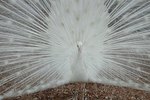
The peacock's extravagant and colorful plumage makes this large member of the pheasant family easy to identify. While all individuals of the species are colloquially referred to as peacocks, this designation accurately describes only males; the correct term for females is peahens. Collectively, they're called peafowl. The two more common peafowl species live in southeast Asia; a third little-known species inhabits a small area of rainforest in central Africa.
Plumage
Only the male peafowl has the species' flamboyant hallmark plumage, which reaches the pinnacle of its splendor when the bird is 5 or 6 years old. The head and neck of the blue, or Indian, peacock, found in Pakistan and India, are covered in iridescent, royal blue feathers arranged like scales. The green peacock of Java and Myanmar has duo-chrome green and bronze body feathers. The peacock's famous train of feathers accounts for about 60 percent of the bird's total body length. When attempting to persuade females -- peacocks are polygamous -- to mate with him, the male erects his tail feathers to create a fan-like display that frames his body. Each tail feather has a eye-like spot known as an oscellus. With a wingspan measuring 4.6 to 5.2 feet, peacocks are among the largest flying birds in the world.
Male vs. Female
While their plumage and coloration are relatively unremarkable, peahens are thought to choose which suitors to mate with based on the grandeur of their train feathers. Indian peahens are largely brown, which allows them to blend into surrounding vegetation and avoid detection by predators. Such camouflage ability is especially crucial when a peahen is incubating eggs and raising chicks, which she does without any help from the male.
Behavior
Peafowl, which are omnivorous, begin their day by foraging for food. A meal may consist of berries, leaves, seeds, insects and even small mammals and reptiles. As part of a universal routine, peafowl subsequently drink water, preen their feathers and settle down in shaded areas to rest. In the cooler afternoon hours, they eat and drink again before retreating to tree tops, where they spend the night in groups. Peacocks have a reputation for being loud and can produce up to 11 vocalizations.
Congo Peafowl
Africa's only true pheasant species is the Congo peafowl, which, unlike its Asian relatives, does not have a train of feathers. Congo peafowl occur exclusively in the dark, dense rainforests of the Democratic Republic of the Congo. Males are mostly blue with a white crest. Females have chestnut-colored feathers on their breasts; their dorsal feathers are green. Unlike in the other peafowl species, Congo peacocks help females feed and protect their offspring.
References
Photo Credits
-
Comstock Images/Comstock/Getty Images
Writer Bio
Since beginning her career as a professional journalist in 2007, Nathalie Alonso has covered a myriad of topics, including arts, culture and travel, for newspapers and magazines in New York City. She holds a B.A. in American Studies from Columbia University and lives in Queens with her two cats.



